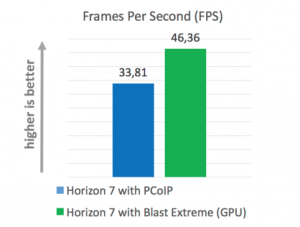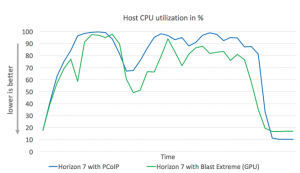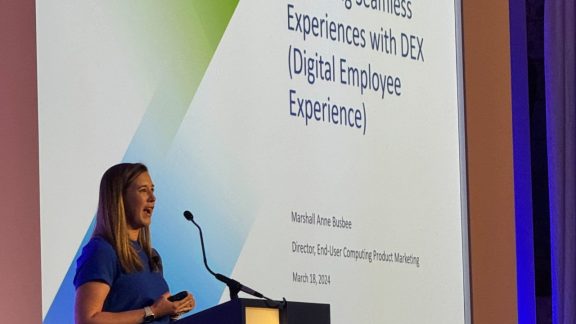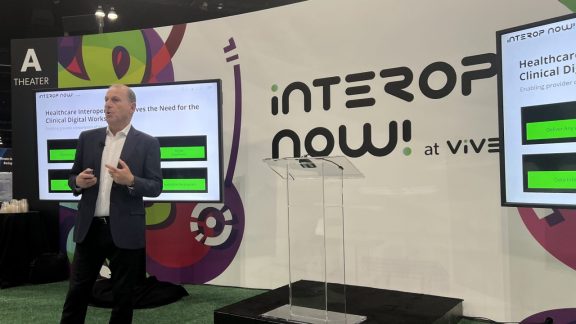When it comes to graphical workloads, users need a crisp, snappy experience or they simply can’t use virtualization. This can be challenging when accessing graphics intense workloads over remote networks due to latency and bandwidth requirements which significantly impact user experience.
With new VMware Horizon 7 and NVIDIA GRID, you can significantly improve latency, bandwidth, and frames per second, while decreasing CPU utilization and increasing users per host by using NVIDIA Blast Extreme Acceleration.
VMware’s new Blast Extreme protocol was built from scratch to deliver remarkable user  experience through the LAN or WAN by using H.264 as the default video codec. The video codec is a very important piece in delivering remarkable user experience since it impacts many factors like “latency”, “bandwidth”, “frames per second (FPS)” and others. Moving to H.264 as the primary video codec also allows VMware to use millions of H.264 enabled access devices to offload the encode/decode process off of the CPU to dedicated H.264 engines on NVIDIA GPUs. This is available with NVIDIA GRID.
experience through the LAN or WAN by using H.264 as the default video codec. The video codec is a very important piece in delivering remarkable user experience since it impacts many factors like “latency”, “bandwidth”, “frames per second (FPS)” and others. Moving to H.264 as the primary video codec also allows VMware to use millions of H.264 enabled access devices to offload the encode/decode process off of the CPU to dedicated H.264 engines on NVIDIA GPUs. This is available with NVIDIA GRID.
Let’s have a closer look at the impact of offloading the encode process from the CPU to the GPU:
The NVIDIA GRID Performance Engineering Team used the ESRI ArcGIS Pro 1.1 workload to simulate real user behavior and monitored the following user experience and scalability metrics for PCoIP, CPU based H.264 encode and NVIDIA GPU based H.264 encode (NVENC):
Latency
Latency directly impacts the user’s experience. If the latency is too high, the end-users will feel the distance of working remotely. Network latency is also the only user experience metric that you can’t optimize by buying more hardware since we are bound by the law of physics. VMware Horizon Blast Extreme doesn’t change the network latency but using GPUs reduces the encode latency and therefore the overall latency is significantly reduced. Using VMware Horizon Blast Extreme with NVIDIA GRID decreased the overall latency by 51ms in comparison to PCoIP and by 27ms compared to VMware Horizon Blast Extreme without GPUs (CPU encode).
Frames per Second (FPS)
Frames per second (FPS) is a measure of how motion frames are displayed on your screen and another important metric for user experience. We were able to increase the frames per second by 37% when using NVIDIA to accelerate VMware Horizon Blast Extreme while running the ESRI ArcGIS Pro 1.1 workload.
Bandwidth
Bandwidth, like the other user experience metrics, is an important factor to consider when moving to VMware Horizon 7. While large, corporate networks are large enough to handle most workloads, often remote networks can become a bottleneck. The required bandwidth is determined by the workload and not having enough bandwidth decreases the user experience. While running ESRI ArcGIS Pro 1.1 with 19 virtual machines, we were able to reduce the required bandwidth by 19% in comparison to VMware Horizon using PCoIP while noticing no impact in image quality.
Host CPU Load and Users per Host (UPH)
While user experience and performance are important measures for a virtual solution, most organizations also look to user density when building environments. Because of this, the NVIDIA GRID Performance Engineering Team focuses on performance and scalability testing. Like many other workloads, the CPU was the first bottleneck we hit when running Esri ArcGis Pro 1.1 with PCoIP. Using VMware’s Blast Extreme Protocol with NVIDIA GRID we were able to decrease the host CPU load by 16% and increase the users per host (UPH) by 3 users (18%).
How VMware Horizon Blast Extreme Acceleration Helps You
User experience and scalability analysis has shown that just by switching the remoting protocol, you can significantly improve the user experience and scalability of your current VMware Horizon environment.
VMware Horizon Blast Extreme with NVIDIA GRID improves your LATENCY, BANDWIDTH, FRAMES PER SECOND, USERS PER HOST and CPU UTILIZATION, and best of all you don’t have to chose between these improvements – you get ALL AT THE SAME TIME!
By Erik Bohnhorst, GRID Performance Architect, NVIDIA












